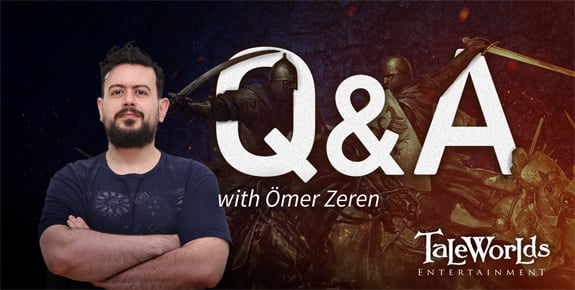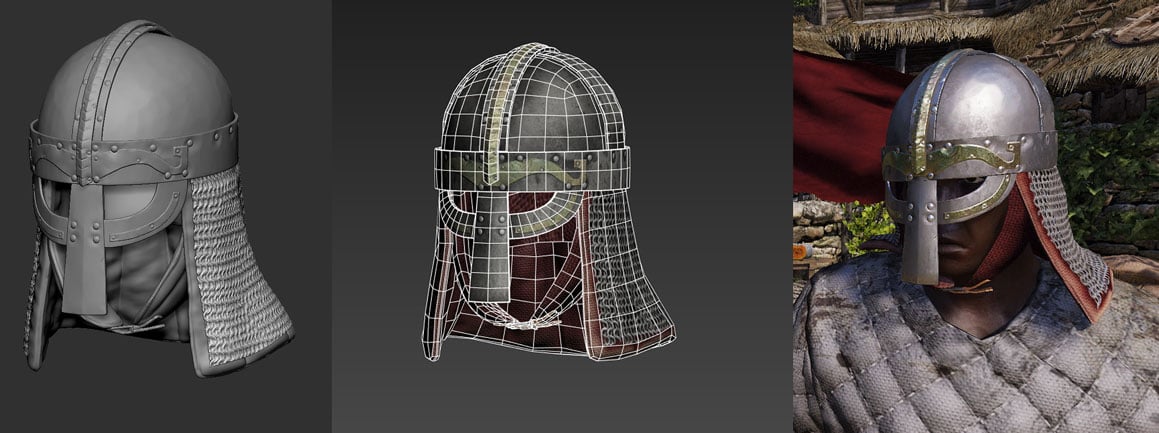
Greetings warriors of Calradia!
For regular followers of this series of blogs, it will come as no surprise to hear that, for Bannerlord, we draw our inspiration for each faction from a number of historical cultures and peoples. Using real-world cultures in this way gives us a great starting point when it comes to creating visual assets for the game. It allows us to create weapons, clothing, armours, buildings and practically everything else in the game in a way which looks and feels authentic to players. However, the low fantasy setting of the game gives us room to inject our own flair and flavour into each item we create, which is something our artists certainly make the most of. In this week’s blog, we talk to one of these artists, Ömer Zeren, who will tell us a little bit about his workflow and what it takes to get a design from the drawing board and into the game.
NAME
Ömer Zeren
FROM
Ankara, Turkey
JOINED TALEWORLDS
2013
EDUCATION
Fine Arts - Visual Communication and Design
OFFICIAL JOB DESCRIPTION
3D Artist
WHAT DO YOU NORMALLY DO DURING YOUR DAY?
“Since I joined the team in 2013, most of my work has revolved around designing and modelling armours and costumes for the game. A design can start with something as simple as a description, such as ‘Vlandian medium leather armour’, or it could be something a little more complex, such as a reference image or a concept design created within the studio. Those are usually the starting points for any of my designs. My next step is to launch ZBrush and to start sculpting! If the final design is approved, I move on to create a low-poly version of the model. I try to be economical with the poly count of course: a full set of armour, head to toe, usually comes to around 7000-10000 polygons. For texturing, I use a number of different programs, including ZBrush Polypaint, Photoshop and at times I use Substance Painter (fabric texture creation is faster with it!). I finish by doing the skinning and import the item into the game to check for errors, etc. If everything looks good and is approved by the boss, I move on to the next one.”
WHAT DO YOU LIKE THE MOST ABOUT BANNERLORD?
“It has to be the handcrafted, huge world of Bannerlord. There are so many possibilities for adventure. You can be a furious warlord or a greedy mercenary, or you could just be minding your own business and have a bandit group or noble lord hunt you down for whatever reason and make your life hell. It's medieval to the core!”
WHAT'S THE MOST DIFFICULT THING THAT YOU SOLVED SO FAR, DURING THE PRODUCTION OF BANNERLORD?
“Tweaking the cloth parts of the armours/costumes for cloth simulation. Basically, there is a lot of trial and error! Our cloth physics system is custom written code that was created in-house and was implemented later on in production. This meant that older models had to be revisited and tweaked for better simulation results (like changing poly loops or simplifying layered meshes). Ironing out the bugs and tweaking the models takes time.” 
WHAT DO YOU CURRENTLY WORK ON?
“I am currently working on some civilian costumes for Aserai. This involves sculpting and texturing lots of fabric and jewellery! For these particular sets, I use concept art created by one of our artists. It’s refreshing after years of leather and metal sculpting! Of course, Aserai has some cool looking heavy armours too, so no worries there!"
WHAT FACTION DO YOU LIKE THE MOST IN BANNERLORD?
“Sturgia. I have worked on a lot of different armours for the game, but with Sturgia there tends to be a bit more variety within the designs for this faction. This is because they are a bit of a mixture of Slavs, Vikings, Russians and Scythians.”
HOW LONG DOES IT TAKE ON AVERAGE TO COMPLETE A MODEL?
“It takes about 2 weeks from scratch to create a fully functional game model. This includes designing, redefining, low-poly, texturing, skinning etc.”

WHEN CREATING A 3D-MODEL, WHAT'S YOUR FAVORITE PART OF THE WHOLE PROCESS?
“My favourite part is adding details in the sculpting process. It’s fun seeing your blocky model come alive.”
DO YOU HAVE SOME SPECIAL REQUIREMENTS FOR THE REFERENCE ART SO THAT YOU CAN CREATE A MODEL FROM IT FLUENTLY? (GOOD QUALITY REFERENCE ART VS. BAD QUALITY REFERENCE ART.)
“Good quality reference art is really important, and it is something we search for as much as possible. Historical accuracy is fairly important to us so we search through historical medieval books and festival photos for as many pictures as we can find. Movies can help too, but we try to avoid the Hollywood bling.”
HOW MUCH CAN YOU USE YOUR OWN CREATIVITY WHEN MODELLING GAME MODELS?
“It depends on the task. If it is something vague like, "European leather armour wearing foot soldier", I can choose the design more freely. But if it is a book illustration of a specific troop or a concept design, I strictly follow the references.”
Join the conversation and comment on the forums! (154 comments)
